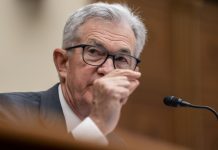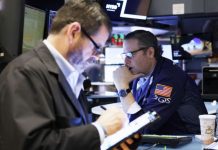
May 2 (UPI) — U.S. markets staged a late turnaround in the first day of trading in May on Monday after a difficult April.
The three major averages found their way into the green in the final hour of trading with the Dow Jones Industrial Average gaining 84.29 points, or 0.29%, after it was down more than 400 points at session lows.
The S&P 500 gained 0.57% and the Nasdaq Composite closed up 1.63%.
April was the worst month for the Dow and S&P 500 since the onset of the COVID-19 pandemic in March 2020, while the Nasdaq had its worst month since 2008.
Tech stocks led the late surge Monday after struggling in April with Facebook parent, Meta, rising 5.32%, while Netflix gained 4.78%, Microsoft climbed 2.5% and Google parent, Alphabet, increased 2.71%.
Intel stock rose 3.14% and Chevron stock gained 1.97% as semiconductor and energy stocks also contributed to Monday’s rebound.
U.S. crude oil prices climbed back to above $105 per barrel, while the 10-year treasury yield climbed to 3%, its highest level since December 2018.
“Three percent is certainly important. … It’s a psychological barrier that’s got people worried about what the Fed is going to do,” said Matt Maley of Miller Tabak.
Investors are awaiting the Federal Reserve’s next monetary policy-setting meeting on Wednesday, at which the central bank is expected to raise interest rates by 50 basis points, the biggest rate hike since 2000.
The Fed also is set to formally announce the beginning of quantitative tightening as it rolls assets off of its $9 trillion balance sheet.
“Recession risk has risen and the financial health of the private sector may ultimately determine whether policy tightening will tilt the economy into a downturn,” Goldman Sachs Chief Economist Jan Hatzius wrote in a note.
“Financial fragility in the private sector has historically amplified the impact of the headwinds confronting today’s expansion: higher interest rates, rapid wage inflation and slowing growth.”






